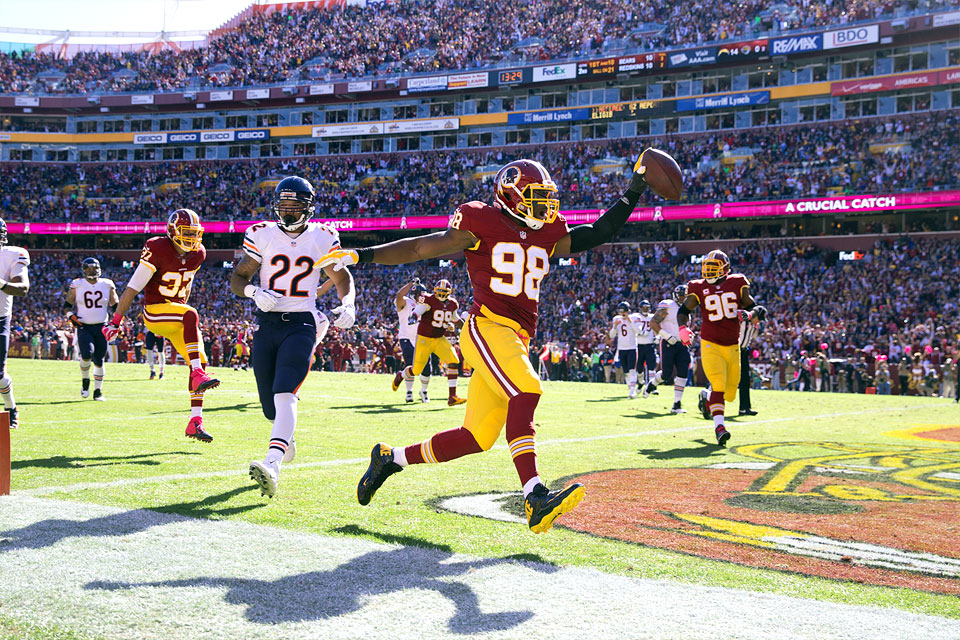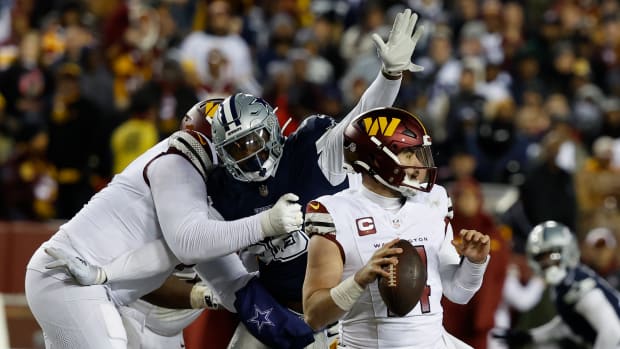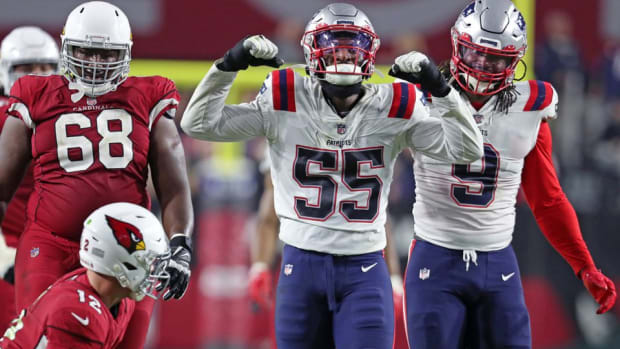
In the NFL’s Game of Tag, You Don’t Want to be It
Monday marked the final day of the NFL’s annual game of tag, a two-week ritual when teams have the ability to remove their top free agent from the marketplace. Four players were franchise-tagged (Saints tight end Jimmy Graham, Jets kicker Nick Folk, Redskins linebacker Brian Orakpo and Panthers defensive end Greg Hardy), two were transition-tagged (Steelers linebacker Jason Worilds and Browns center Alex Mack) and a few others (Dolphins cornerback Brent Grimes and Chargers linebacker Donald Butler) signed a long-term contract to avoid being tagged.
The tags are valuable management weapons that lock down top players when their earning power is at its peak; they also directly influence negotiations for elite NFL players and indirectly influence negotiations for others. While one-year earnings are high, the tags prevent some of the NFL’s best players from establishing true market value. We can speculate about the actual worth of Hardy and Graham, but we’ll never know because they weren’t allowed to join the 2014 free agent class.
Beyond the financial constraints, being tagged can take a psychological toll. Despite their stoic public personas, most players are highly emotional beings who want strong commitment from their team in the form of a long-term financial deal. But tags allow teams to avoid making such commitments. Consider what the Titans did with Albert Haynesworth: they were willing to invest substantial money while “dating” him on the tag; the Redskins then unwisely put a ring on his finger, only to divorce after a couple years.
One of my mantras about professional athletes and negotiations is: Never underestimate the power of ego and insecurity. It drives everything.
The ‘disenfranchised’
The franchise tag was originally designed to keep true “franchise players”—quarterbacks such as Dan Marino and John Elway—on their teams. Its use has now expanded to restrain a team's best free agent for that particular year, a much more potent application. The new CBA calculation of the tag has held the salaries in check. While the tag number was previously determined by averaging the top five salaries at a player's position from the preceding year, it is now based on a formula that averages the top five salaries at a player's position for the preceding five years. This new twist has led to flat, and sometimes even lowers numbers since the inception of the new CBA. Here is a comparison, in millions, between franchise tag numbers for 2011, when the salary cap was $120 million, and this year, with a $133 million cap:
| Position | 2011 | 2014 |
↑ | Quarterback | 16.1 | 16.9 |
↔ | Running back | 9.6 | 9.5 |
↓ | Tight end | 7.3 | 7 |
↔ | Defensive end | 13 | 13.1 |
↓ | Defensive tackle | 12.5 | 9.7 |
↓ | Cornerback | 13.5 | 11.8 |
↓ | Safety | 8.8 | 8.4 |
Many franchise tag contracts from three years ago exceed today’s payouts, a startling fact with the assumed inflation of salaries.
I understand the NFLPA’s position regarding the tag: they didn’t prioritize an issue that affects only a few players a year. However, lower tag amounts not only affect elite players, the issue trickles down to influence negotiations for all players. The tags empower teams to bargain more assertively with elite players, which in turn changes the negotiation parameters for everyone.
Rekindling the transition game
The rarely used transition tag has been employed by the Browns and Steelers this offseason. It allows a player to negotiate a contract elsewhere, but the player then has to go back to the incumbent team and give it a chance to match the offer. In 2005, as vice president of the Packers, I used the transition tag on tight end Bubba Franks. His agent and I had differing opinions on Franks’ market value, so we allowed the marketplace to help move along negotiations (Franks received no other offers).
Jason Worilds putting a hit on Peyton Manning. (Peter Read Miller/Sports Illustrated/The MMQB)
The transition tag had been dormant since the infamous “poison pill” contract presented to the Seahawks, by the Vikings in 2005, which tied lineman Steve Hutchinson’s compensation to the Seahawks’ Walter Jones, making it exceedingly onerous for the Seahawks to match. I vividly remember the NFL Management Council dressing down the Vikings front office at the league meetings that year, as well as the steam coming out of Seattle coach Mike Holmgren’s ears. Thanks to the Vikings and Hutchinson, poison pill offer sheets are now forbidden in the new CBA.
Beyond those tactics, teams can still creatively front-load offer sheets in a “pay as you go” structure that I outlined last week. The Browns, flush with cap room, are equipped to match any challenge for Mack. The Steelers are as cap-strapped as any team, having just mortgaged the contract of 31-year-old tight end Heath Miller, and would have been vulnerable to an attack from another team’s offer sheet with a cap-loaded first year regarding Worilds.
Yet, surprisingly, Worilds immediately signed his tender and took himself off the market, eliminating any such threat to the Steelers. Such a move by Worilds suggests there might have been some concern that Pittsburgh would rescind the tender at some point with mounting cap issues, or that negotiations on a long-term contract were progressing before the tag deadline and the player (and agent) feel confident there will be resolution. In either case, my sense is that there will be some veteran casualties coming in Pittsburgh due to this tag or potential contract. There will be blood.
Historically, teams have reluctant to play the transition tag game, as many are wary of negotiating contracts for their competitors. Unless the new-suitor teams can be sure that the incumbent team cannot or will not match, most will steer clear.
It’s all how you position yourself
Jimmy Graham (John W. McDonough/Sports Illustrated/The MMQB)
No discussion of the NFL’s 2014 game of tag would be complete without mentioning the Saints and Jimmy Graham. First, no team is going to offer two first-round draft choices for Graham; the Saints would shut down Bourbon Street with a party if someone actually did. High draft choices are the most valuable currency in the NFL; teams are too smart to part with two of them for any player.
The NFLMC has applied the tight end tender amount to Graham ($7 million) rather than the wideout number ($12.3 million). Although an interpretation of the CBA language could favor Graham getting the higher amount—he split out for “the most plays” in 2013—the NFL believes Graham epitomizes the way many teams schematically use a tight end. The NFL will also point out that Graham played tight end in college; was drafted as a tight end; is listed on the roster and depth chart as a tight end; and was voted to the Pro Bowl as a tight end. Still, Graham’s agent, Jimmy Sexton, may file a grievance for the higher tender and head to arbitration. There will be lawyers.
The “which position” debate is secondary to the real issue: Graham’s long-term earnings. And there lies the rub of the franchise tag. If the Drew Brees negotiation of 2012 is a guide, Saints general manager Mickey Loomis will let the tag ride until the July deadline nears, then say something to this effect: “You can have your $7 (or $12 million) and we talk next year, or you can take this five-year deal.” While the deal may have, say, $20 million guaranteed instead of Graham’s desired $30 million, he will be hard-pressed to turn down that level of security.
Which brings us back to where we started: the power of the tags. If contract negotiations are about one thing it is the allocation of risk. The tags exist to transfer the risk of future security, in a sport with a 100% injury rate, to the player. These are powerful weapons.
Andrew Brandt served as the vice president of the Packers from 1999 to 2008.







































